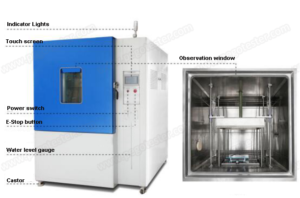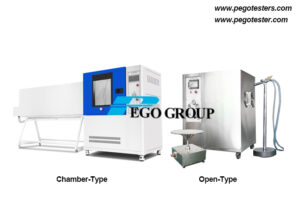Under complex winter road conditions, automotive electronic components (such as on-board sensors, ECU electronic control units, and wire harness connectors) often face the harsh scenario of “hot components coming into contact with cold water”. For example, hot parts in the engine compartment may splash with ice water from the road, or electronic components may be briefly immersed in low-temperature water when the vehicle wades through water.
This working condition—combining sudden temperature changes and mechanical environments—easily causes problems like uneven thermal expansion and contraction of materials and seal failure, directly threatening the safety of vehicle operation.
As a dedicated device that meets the requirements of Clauses 5.4.2 and 5.4.3 of the international standard ISO 16750-4, the Ice Water Shock Test Chamber (with ice water splash and submersion functions) accurately reproduces such extreme scenarios, making it a core tool for automotive electronics reliability testing.
I. Test Principle: Simulate Real Working Conditions to Expose Potential Failure Risks
The core goal of the ice water shock test is to simulate the physical process of “hot electronic components contacting cold water” when a vehicle travels in winter, and verify the component’s resistance to sudden temperature changes and water media.
The device supports two optional modes: splash test and submersion test. Its specific procedures strictly follow the requirements of ISO 16750-4:
1). Ice Water Splash Test
For the scenario where “ice water splashes onto hot components” when a vehicle is moving, the test process is as follows:
Place the Device Under Test (DUT) in the heating chamber of the equipment, and heat it continuously at the maximum operating temperature (Tmax) for 1 hour (or until the DUT temperature stabilizes) to simulate the hot state of the component during normal operation.Use a nozzle to spray cold water (0℃~+4℃) onto the DUT for 3 seconds. A cold water tank (submersion tank) is installed under the heating chamber to provide a stable low-temperature water source for the splash test.
2). Ice Water Submersion Test
For the scenario where “hot components are briefly immersed in ice water” when a vehicle wades through water, the test process is as follows:
Follow the same preliminary step as the splash test: heat the DUT at Tmax in the heating chamber for 1 hour (or until the temperature stabilizes), and keep the device running throughout the process.
Use a cylinder to drive a chain to lift and lower the DUT, transferring it directly from the heating chamber to the cold water tank below. The submersion depth is ≥10mm, and the submersion duration is 5 minutes.
The temperature of the cold water tank is maintained at 0℃~+4℃. Note that the submersion test and splash test cannot be conducted simultaneously and require separate parameter settings.
The core value of both tests lies in exposing failures caused by “differences in thermal expansion coefficients of materials due to sudden temperature changes”—such as housing cracks, aging of sealing strips, detachment of circuit solder joints, or short circuits caused by ice water infiltration. This provides data support for product design optimization.
II. Core Features: Multi-Dimensional Design to Ensure Test Accuracy and Compliance
The design of the ice water shock test chamber centers on three cores: “standard compliance, test stability, and operational convenience”. It achieves professional-level testing capabilities from dimensions such as material, temperature control, and automatic control. Its key features are as follows:
1). Corrosion Resistance and Thermal Insulation: Lay a Solid Foundation for Equipment Performance
Material Selection: The inner wall of the test chamber and the nozzles of the spray slot all use SUS316 stainless steel, which has excellent low-temperature resistance and rust resistance, preventing equipment damage caused by long-term contact with ice water. The inner panel of the chamber door also uses SUS316 stainless steel, paired with a door handle that has no chemical reaction, balancing durability and operational safety.
Thermal Insulation Design: The chamber is filled with high-density glass fiber cotton, which can effectively block temperature differences between the inside and outside, ensuring uniform and stable temperature inside the chamber and avoiding test accuracy issues caused by heat loss.
2). Observation and Operation: Dual Guarantee of Visualization and Convenience
Real-Time Observation: The chamber door is equipped with a transparent observation window made of multi-layer hollow tempered glass and built-in LED lighting. You can clearly observe the state changes of the DUT during the test and monitor abnormalities without interrupting the test.
Flexible Wiring: A test hole with a diameter of 100mm is installed on the left side of the equipment, which can be used to connect the power cord or signal line of the external DUT, meeting the test requirement of “continuous operation of the equipment” during the test.
Convenient Movement: High-quality PU movable Korean casters are installed at the bottom of the machine, allowing you to easily move the equipment to the designated workstation. After positioning, lock the casters to fix the equipment, adapting to the flexible layout of the laboratory.
3). Temperature Control and Refrigeration: Stably Provide Low-Temperature Environment
Ice Water Temperature Control: Adopt water circulation refrigeration to ensure uniform water temperature (0℃~+4℃) in the cold water tank and stable state of the ice-water mixture, avoiding local freezing or temperature fluctuations.
Refrigeration System Configuration: The refrigeration system is installed at the bottom of the equipment. The compressor uses the French Taikang brand, which has strong refrigeration efficiency and reliability. The condensation method is air-cooled, and it uses R404R environmentally friendly refrigerant, complying with environmental protection requirements.
System Sealing: Double-layer high-temperature and high-pressure sealing strips are used between the chamber door and the machine body to ensure the airtightness of the test area and prevent temperature leakage. The pipelines of the refrigeration system have undergone a 48-hour pressure leak test to ensure long-term stable operation. The shell-and-tube heat exchanger also uses SUS316 stainless steel, which can resist corrosion from salt water (if it is necessary to simulate ice water containing salt).
4). Automation and Precision Control: Digitization Improves Test Efficiency
Intelligent Control System: Equipped with a 7-inch touch screen + PLC programmable logic controller. The electrical components use well-known brands such as LS and Omron. The wiring process complies with Chinese national standards, with a reasonable electric board layout, firm wiring, and clear markings. The operation is intuitive and troubleshooting is convenient.
Precise Flow Control: The splash test is equipped with an digital flowmeter, which collects water flow signals in real time and feeds them back to the PLC. It realizes automatic constant flow control through the PID algorithm, and the flow data is directly displayed on the touch screen to ensure that the spray intensity meets standard requirements. At the same time, a customized circulation pump is used to ensure stable water flow and water temperature.
Adjustable Submersion Parameters: The submersion duration (1~5 minutes) and cycle times (1~999 times) of the submersion test can be set freely. The temperature recovery time of the cold water tank is 30 minutes. The water tank is equipped with automatic high and low water level control: the high water level is used for the submersion test, and the low water level is used for the splash test to reduce water waste.
5). Cleaning and Maintenance: Reduce Equipment Operation and Maintenance Costs
The equipment has an automatic cleaning function for pipelines and inner tanks, which can regularly remove residual scale or impurities, avoiding test accuracy issues caused by pollutants. At the same time, the spray slot nozzles adopt a detachable design, which facilitates separate cleaning and further extends the service life of the equipment.
III. Industry Value: A Reliable “Gatekeeper” Throughout the Automotive Electronics Industry Chain
As a key testing equipment in the automotive electronics field, the ice water shock test chamber is used throughout the entire process of R&D, production, and certification to ensure product quality:
R&D Stage: Automotive manufacturers and component suppliers can use this equipment to verify the design of new products—for example, testing the performance of different sealing materials (such as silicone sealing rings and PCB coatings) under ice water shock, optimizing the ECU housing structure to avoid water accumulation, or adjusting the waterproof level of wire harness connectors to reduce failure risks from the source.
Production Quality Inspection: During mass production, enterprises can conduct sampling tests (such as selecting a certain proportion of DUTs for splash/submersion tests in each batch) to check production process defects (such as poor sealing caused by injection molding burrs and false soldering of solder joints), preventing unqualified products from entering the market.
Third-Party Certification: Testing institutions (such as SGS and TÜV) use this equipment to conduct compliance certification for automotive electronic components in accordance with ISO 16750-4. Only products that pass the ice water shock test can meet the access requirements of mainstream automotive markets such as the European Union and North America, helping enterprises “go global”.
In summary, the ice water shock test chamber is not only a “compliance tool” that aligns with ISO 16750-4 but also a “reliability line of defense” for automotive electronics from design to mass production. With the rapid development of new energy vehicles and intelligent driving technology, its ability to accurately simulate extreme working conditions will continue to provide core support for the safe and stable operation of on-board electronic components.




